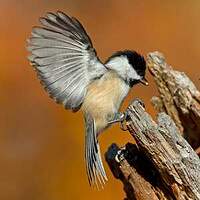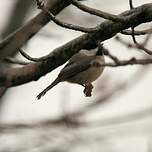Black-capped Chickadee
Poecile atricapillus - Mésange à tête noire
Identification
The Black-capped Chickadee is a small, widespread and usually very common bird in North America. Its plumage is sober, without the bright colors of the birds of the Old World. To a European observer, it recalls the Boreal Chickadee by its plumage and the Nuthatch by its voice.
There is no sexual dimorphism. The upper parts, from the cape to the shoulder and shoulder blades, are a rather cold gray-brown. The lower parts, from the chest to the under tail covers, are white tinged with russet that can become light fawn on the sides, which contrasts nicely with the top. The feathers of the wings and tail, of a blackish gray, have a clear gray-white to whitish edge on their outer edge, particularly marked on the remiges secondaries and tertiaries and on the large coverts, the whole forming a large pale area in the wing. The head is black and white. The cap is a slightly glossy black that includes the dark eye and extends to the nape. The black from the chin and throat reaches the upper chest and widens into a triangle on the sides. The white cheeks begin in a point at the level of the beak, widen and extend to the nape. The beak is black and the legs a dark gray.
There are differences in the background color of the plumage depending on the subspecies. To make a long story short, the birds of the eastern part of the continent have warmer tones than those of the western part and the variation is clinal.
The juvenile is little different from the adult. Its colors are a little less sharp, the cap is not glossy, the bib less clearly defined, the base of the beak a little clearer, but from the post-juvenile moult, it is no longer distinguished from the adult.
Subspecific information 9 subspecies
- Poecile atricapillus atricapillus (e Canada to c and ne USA)
- Poecile atricapillus turneri (c and s Alaska and nw Canada)
- Poecile atricapillus occidentalis (coastal sw Canada and nw USA)
- Poecile atricapillus fortuitus (inland sw Canada and nw USA)
- Poecile atricapillus septentrionalis (w and c Canada to c USA)
- Poecile atricapillus bartletti (Newfoundland)
- Poecile atricapillus garrinus (wc USA)
- Poecile atricapillus nevadensis (w USA)
- Poecile atricapillus practicus (Appalachian Mts.. e USA.)
Foreign names
- Mésange à tête noire,
- Carbonero cabecinegro,
- chapim-de-barrete-preto,
- Schwarzkopfmeise,
- kanadai cinege,
- Amerikaanse Matkop,
- Cincia capinera,
- amerikansk talltita,
- Amerikameis,
- sýkorka čiapočkatá,
- sýkora černohlavá,
- Amerikansk Fyrremejse,
- amerikanhömötiainen,
- mallerenga capnegra americana,
- sikora jasnoskrzydła,
- melngalvas zīlīte,
- Черношапочная гаичка,
- アメリカコガラ,
- 黑顶山雀,
- amerikansk talltita,
- 黑枕山雀,
Voice song and call
As with all chickadees, the Black-capped Chickadee emits sharp tseets which are contact calls. Their usual nasally che-dee call and its variants is very similar to the Carolina Chickadee's. It has the same tone. This call is how it got its anglo-saxon name chickadee. Also heard are repeated seeseeseesees and doodleoos or a combination of the two into a monotone seedoodleoo. Sometimes a liquid babble is interspersed with the other calls and serves as a binding element.
The song, a bi-tonal seedooodoo often repeated, is typical. It resembles the call but with a more musical quality and on two tones, with the last two syllables much lower than the first. It can be heard at the heart of winter. It is part of the soundscape of northern forests after winter leaves.
Habitat
The Black-capped Chickadee is a forest species, occupying a wide variety of deciduous and coniferous habitats, mainly at low altitudes in the north of its range and at higher altitudes in the south, for example up to 3,000 meters in New Mexico.
Behaviour character trait
The Black-capped Chickadee is a common species and its familiarity is astonishing. In national parks and reserves, all it takes is extending a hand with some seeds to attract it, and it will come and rest without fear.
This species is sedentary and thus present all year round in its habitat. It is territorial during the reproductive period and then becomes gregarious, forming loose groups, often composed of multiple species, which methodically exploit wooded habitats. During this season, it is always the most common and regular species at feeding points, an activity which is very popular in the north of the United States and Canada. Its reproduction can be encouraged by putting up nest boxes.Dietfeeding habits
Like all other chickadees, the Black-capped Chickadee has a mixed diet, mostly insectivorous during the summer season and becoming granivorous in winter.
The young are fed insects and their larvae, particularly lepidoptery caterpillars, which are easy to catch and rich in protein. The diet also includes other arthropods, such as spiders and millipedes, as well as small mollusks. The basis of the winter diet consists of tree seeds, for example those of Tsuga. It also feeds on fruits such as those of Rubus or Vaccinium, or drupes of Rhus copallinum.It is easy to attract it in winter with suet and seeds, such as sunflower seeds. Hard-shelled seeds are tapped and cracked with the beak.
Reproduction nesting
The Black-capped Chickadee species is monogamous and it seems like stable couples remain together all year.
As a result, courtship season is discreet in late winter, consisting of singing and a few Gestures. The nesting cavity is dug out by both partners in the wood of a dead or broken branch. Sometimes, they occupy an old woodpecker cavity, or a nest box if one has been provided to them, or a hollow pole or pylon. The bottom of the cavity is lined mostly with moss, on which it adds leaves, herbs, animal and vegetable fibers, following the usual pattern of a paridae nest.The female generally only lays one clutch per season; this consists of 6-8 white rosé eggs with light brown speckles. It is incubated for 11-14 days by the female, with food being provided by the male. The young are fed in the nest for around two weeks. After they can fly, they will still remain dependent on their parents for almost a month, although they are already able to feed themselves by the time they are three weeks old.
Geographic range
The range of the Black-capped Chickadee extends across North America from southern Alaska in the West to Newfoundland in the East, in a continuous band stretching from the boreal forests in the North to the Central US in the South. 9 subspecies are divided by this vast range, in which the species is sedentary.
Threats - protection
Sources of information
- IOC World Bird List (v15.1), Gill, F and D Donsker (Eds). 2025-12-07.
- Chickadees, tits , nuthatches and treecreepers, Harrap Simon
- Avibase, Lepage Denis
- HBW Alive,
- xeno-canto, Sharing bird sounds from around the world,
Other sources of interest
 Specification sheet created on
22/07/2023 by Jean François
Specification sheet created on
22/07/2023 by Jean FrançoisTranslation by AI Oiseaux.net
© 1996-2026 Oiseaux.net
- Accipitriformes
- Aegotheliformes
- Anseriformes
- Apodiformes
- Apterygiformes
- Bucerotiformes
- Caprimulgiformes
- Cariamiformes
- Casuariiformes
- Charadriiformes
- Ciconiiformes
- Coliiformes
- Columbiformes
- Coraciiformes
- Cuculiformes
- Eurypygiformes
- Falconiformes
- Galliformes
- Gaviiformes
- Gruiformes
- Leptosomiformes
- Mesitornithiformes
- Musophagiformes
- Nyctibiiformes
- Opisthocomiformes
- Otidiformes
- Passeriformes
- Pelecaniformes
- Phaethontiformes
- Phoenicopteriformes
- Piciformes
- Podargiformes
- Podicipediformes
- Procellariiformes
- Psittaciformes
- Pterocliformes
- Rheiformes
- Sphenisciformes
- Steatornithiformes
- Strigiformes
- Struthioniformes
- Suliformes
- Tinamiformes
- Trogoniformes
































